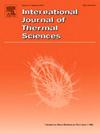Overall cooling effectiveness of blade leading edge with double swirl chamber: effect of turbulence intensity and wall thickness
IF 4.9
2区 工程技术
Q1 ENGINEERING, MECHANICAL
International Journal of Thermal Sciences
Pub Date : 2025-05-17
DOI:10.1016/j.ijthermalsci.2025.110008
引用次数: 0
Abstract
This paper experimentally studied the film cooling characteristics of the leading edge with a double swirl chamber under different crossflow conditions. The experiment matching the Biot number (BI) of actual blades, and the effects of aerodynamic and structural parameters, such as turbulence intensity and leading edge wall thickness, on the overall cooling performance were comprehensively considered. An infrared thermal imager photographed the observed wall temperature, and the leading edge surface's overall cooling effectiveness distribution law was obtained. The results show that the blowing ratio redistribution due to the crossflow in the double swirl chamber dramatically improves the cooling protection under small blowing ratio conditions and avoids the risk of the mainstream backflow at the stagnation line. The Biot number significantly affects the overall cooling performance, and the effect of material thermal conductivity leads to a significant enhancement in the area-averaged overall cooling effectiveness at all conditions. The coolant with a small blowing ratio under crossflow conditions significantly improves the overall cooling performance near the stagnation line under the effect of material thermal conductivity, especially at the large crossflow intensities and low blowing ratio condition, where thermal conductivity cases are elevated by 88.78 % and 191.5 %, respectively, compared with adiabatic case. Under each condition, area-averaged overall cooling effectiveness gradually decreases with the wall thickness increase. The heat transfer of the thick wall in the tangential direction within the solid domain is insufficient, and a clear low overall cooling effectiveness region appears in the contours.
双旋流室叶片前缘整体冷却效果:湍流强度和壁厚的影响
实验研究了不同横流条件下双旋流腔前缘的气膜冷却特性。综合考虑了与实际叶片Biot数(BI)匹配的实验,以及湍流强度、前缘壁厚等气动参数和结构参数对整体冷却性能的影响。利用红外热像仪对观察到的壁面温度进行了拍摄,得到了前缘表面整体冷却效率的分布规律。结果表明,双旋流腔内的横流导致的吹气比重分配显著提高了小吹气比条件下的冷却保护效果,避免了主流在滞止线处回流的风险。Biot数显著影响整体冷却性能,材料导热系数的影响导致在所有条件下的面积平均整体冷却效率显著提高。在横流条件下,小吹气比的冷却剂在材料导热系数的影响下,显著提高了滞止线附近的整体冷却性能,特别是在大横流强度和低吹气比条件下,导热系数分别比绝热情况提高了88.78%和191.5%。在各工况下,随着壁厚的增加,面积平均总冷却效率逐渐降低。固畴内厚壁切向换热不足,等高线上出现明显的低整体冷却效率区。
本文章由计算机程序翻译,如有差异,请以英文原文为准。
求助全文
约1分钟内获得全文
求助全文
来源期刊

International Journal of Thermal Sciences
工程技术-工程:机械
CiteScore
8.10
自引率
11.10%
发文量
531
审稿时长
55 days
期刊介绍:
The International Journal of Thermal Sciences is a journal devoted to the publication of fundamental studies on the physics of transfer processes in general, with an emphasis on thermal aspects and also applied research on various processes, energy systems and the environment. Articles are published in English and French, and are subject to peer review.
The fundamental subjects considered within the scope of the journal are:
* Heat and relevant mass transfer at all scales (nano, micro and macro) and in all types of material (heterogeneous, composites, biological,...) and fluid flow
* Forced, natural or mixed convection in reactive or non-reactive media
* Single or multi–phase fluid flow with or without phase change
* Near–and far–field radiative heat transfer
* Combined modes of heat transfer in complex systems (for example, plasmas, biological, geological,...)
* Multiscale modelling
The applied research topics include:
* Heat exchangers, heat pipes, cooling processes
* Transport phenomena taking place in industrial processes (chemical, food and agricultural, metallurgical, space and aeronautical, automobile industries)
* Nano–and micro–technology for energy, space, biosystems and devices
* Heat transport analysis in advanced systems
* Impact of energy–related processes on environment, and emerging energy systems
The study of thermophysical properties of materials and fluids, thermal measurement techniques, inverse methods, and the developments of experimental methods are within the scope of the International Journal of Thermal Sciences which also covers the modelling, and numerical methods applied to thermal transfer.
 求助内容:
求助内容: 应助结果提醒方式:
应助结果提醒方式:


